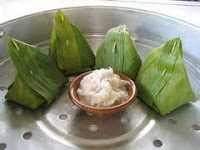Num Anksom
Num Anksom, which is covered by banana leaves and boiled well before consomption, consist of two kind: Anksom Chrouk and Anksom Chek. Anksom Chrouk (pig cake) is mainly made out of pork, sticky rice, peeled mung bean and pepper, while Anksom Chek consist of ripe banana and other ingredients used in AnksomChrouk, excerpt the pork and pepper. Num Anksom is one of the most popular traditional cakes Cambodians make during traditional ceremonies or festivals, particularly on Phchum Ben (Festival of the dead) and Khmer New Year.
Num Korm
Similar to Num Anksom, Num Korm is used for traditional ceremonies or festivals, particularly during the Khmer New Year and Phchum Ben (Festival of the dead) It is pyramidal, and is either sweet or succulently salty.
Num Slek Sros (Fresh Leaf Num)
Cambodians name it because it is packaged in a piece of fresh green banana leaf. The slightly sweet cake comes from sticky flour with peeled mung bean inside serving as the core. It is eaten during traditional festivals, parties and other events, mostly as dessert.
Cambodian Waffle
It consist of sticky rice flour mixed with coconut oil, palm or white sugar, eggs and salt. It is not expensive, and many Cambodians think its tastes best when it is still hot.
Num Akor
It is round, made out of sticky rice flour mixed with coconut milk and palm sugar or white sugar with shredded coconut and toasted sesame on the top. It comes in two colors- white and red and it is also used as an offering on a Buddhist holy day.
Num Cak Kachan
It is sweet, and has numerous layers of various colors such as white and red, or green and white. Cambodians buy it for a Biddhist holy day to eat at home.
Moon Cake
Although traditionally used by the Chinese for the Moon Festival, the Moon cake is very popular in Cambodia, especially with Chinese-Cambodians. The Chinese eat the Moon cake when there is a full moon.
Num Krouch
It is called so because it looks like an orange, though orange is not part of the ingredients. Fried, Num Krouch consist of flour with peeled mung bean mixed with sugar serving as the core, toppled with toasted sesame. In general, it is popular with Cambodian kids.
Num Chek Bok (Crushed Banana Cake)
It is made out of sticky rice flour, coconut milk and ripe banana. It is eaten as a snack at home after meals.
Num Ple'ay
It is made out of flour and palm sugar. It is round, small with a sugar ball inside. In rural areas, it is eaten in a small banana leaf basket, which contains over five Num Ple'ay balls or more depending on how much you want to pay.

















